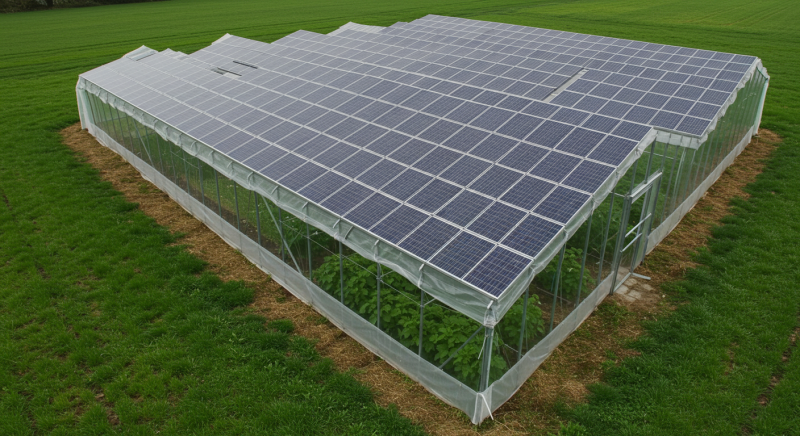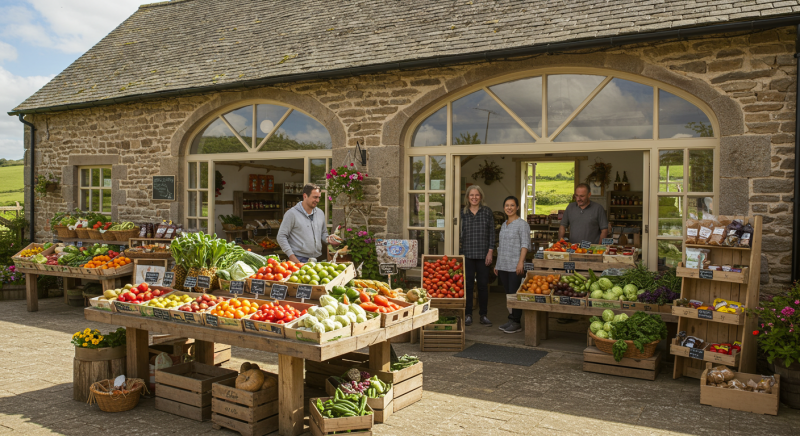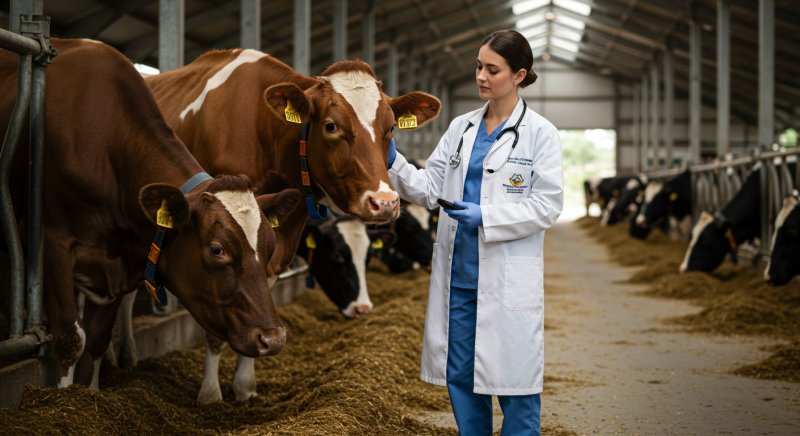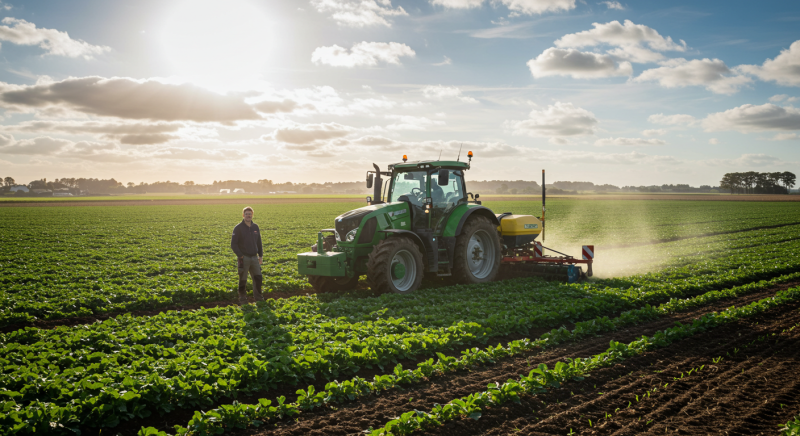Are you a U.K. farmer wondering how to secure funding to modernise your operations, boost sustainability, or protect livestock in 2025? With climate challenges, evolving regulations, and rising costs, accessing financial support has never been more critical. This guide unpacks the latest funding options for farmers in the U.K., from productivity grants to environmental schemes, and explains how to navigate applications successfully.

Key Takeaways
- Environmental Land Management (ELM) schemes dominate 2025 funding, with expanded grants for sustainable practices.
- Productivity-focused grants like the Farming Equipment and Technology Fund (FETF) offer up to £25,000 for equipment.
- Animal welfare and health grants now allow multiple claims per species, with vet visits funded up to £923.
- Landscape Recovery and woodland creation grants support large-scale environmental projects.
- Application deadlines vary: Some schemes close in 2025, while others accept submissions year-round.
2025 Updates: Key Funding Options for Farmers in the U.K.
The U.K. government has committed £5 billion over 2024–2026 to support farmers in transitioning to sustainable practices while boosting productivity and resilience in the agricultural sector. Below is a breakdown of the most critical funding options for farmers in the U.K. for 2025, including new schemes, revised deadlines, and strategic priorities:
1. Environmental Land Management (ELM) Schemes
The Sustainable Farming Incentive (SFI) remains a cornerstone of ELM, though it is currently closed to new applicants after reaching its £1.05 billion budget cap in March 2025. Existing agreements cover 37,000 farms, with payments averaging £1,050 per hectare for actions like soil health improvement and hedgerow maintenance. Farmers in existing SFI agreements will continue receiving payments until 2028, with Defra planning a revised SFI scheme post-Spending Review, focusing on food security and nature recovery.
The Countryside Stewardship Higher Tier (CSHT), opening in summer 2025, targets upland farmers and landowners managing ecologically sensitive areas like SSSIs or woodlands. Pre-application advice from Natural England or the Forestry Commission is mandatory, with grants tailored to land management actions such as peatland restoration or flood mitigation.
For large-scale collaborations, the Landscape Recovery scheme funds projects spanning 500+ hectares to restore wetlands, peatlands, or wildlife corridors. While the 2024 application window is closed, Defra plans to reopen submissions for 2026, prioritizing carbon sequestration and biodiversity.
2. Farming Investment Fund (FIF)
The Farming Equipment and Technology Fund (FETF) reopened in spring 2025 with £30 million allocated for productivity tools (e.g., GPS-guided machinery, robotic weeders) and £16.7 million for animal welfare upgrades like automated health monitors. Grants range from £1,000 to £25,000, with a streamlined application process via GOV.UK.
The Improving Farm Productivity Grant offers up to £500,000 for robotics/automation (e.g., milking systems) and £100,000 for solar PV installations. Applications for invited candidates close on 31 July 2025, emphasizing renewable energy integration.
3. Animal Health and Welfare Grants
Farmers can now claim £215–£923 per review for vet visits across cattle, sheep, and pigs, with follow-up funding for disease management (e.g., BVD in dairy herds). Specialized grants include:
- Laying Hen Housing Grant: Up to £500,000 for housing upgrades or veranda additions to improve poultry welfare (deadline: 30 January 2026).
- Calf Housing Grant: Up to £500,000 for calf housing improvements (deadline: 30 April 2025).
4. Woodland Creation and Tree Health
The England Woodland Creation Offer (EWCO) provides £10,200–£22,900 per hectare for new forests, with additional payments for projects in regions like Cornwall or Northumberland. Farmers managing diseased trees (e.g., ash dieback) can apply for the Tree Health Pilot Scheme, covering 80% of felling costs.
5. Innovation and Research Grants
The Farming Innovation Programme (FIP) has allocated £42.5 million for projects like methane-reducing cattle feed or semi-transparent solar panels. The new ADOPT Fund (£20 million) supports farmer-led trials of emerging technologies, with grants of £50,000–£100,000.
6. Capital Grants and Diversification Support
Reopened in 2025, Capital Grants fund water/air quality improvements, natural flood management, and boundary/tree projects, with caps of £25,000–£35,000 per category. Farmers diversifying into eco-tourism or renewable energy can leverage the Biodiversity Net Gain (BNG) scheme, selling habitat credits for long-term income.
7. Seasonal Worker Scheme and Tax Considerations
The Seasonal Worker Visa Scheme has been extended to 2030, with 43,000 roles allocated for 2025 to address labor shortages in horticulture. However, proposed inheritance tax changes (effective April 2026) may impact family-run farms, with relief reduced for assets over £1 million 410.
Key Deadlines and Strategic Tips
- FETF: Submit early due to first-come, first-served allocation.
- CSHT: Begin pre-application consultations in January 2025.
- Slurry Infrastructure Grant: Full applications due by 27 June 2025.
For real-time updates, farmers are advised to consult the Defra Farming Blog or the GOV.UK grants page .
How to Apply for Funding: A Step-by-Step Guide for U.K. Farmers
Navigating the application process for agricultural grants can feel overwhelming, but breaking it down into clear, actionable steps simplifies the journey. Below is a detailed roadmap to help you secure funding options for farmers in the U.K. in 2025:
Step 1: Confirm Your Eligibility
Before diving into applications, verify whether you qualify for the specific grant or scheme. Most funding options for farmers in the U.K. require applicants to hold a Single Business Identifier (SBI), a unique code assigned to your farm business by the Rural Payments Agency (RPA). If you haven’t registered yet, visit the RPA website to complete the process.
Tenant farmers must ensure their tenancy agreement covers at least three years beyond the grant period. For example, if applying for a five-year Countryside Stewardship agreement, your tenancy must extend to eight years. Landlords must provide written consent for capital investments like solar panels or livestock housing upgrades.
Step 2: Align Your Goals with the Right Scheme
Not all grants are created equal. Identify which funding options for farmers in the U.K. align with your operational priorities:
- Productivity-focused farmers: Prioritize the Farming Equipment and Technology Fund (FETF) or Improving Farm Productivity grants for robotics and renewable energy.
- Sustainability-driven landowners: Target the Environmental Land Management (ELM) schemes, such as the upcoming Countryside Stewardship Higher Tier or Landscape Recovery grants.
- Livestock and poultry farmers: Explore Animal Health and Welfare grants, which now cover vet consultations for multiple species.
Use the GOV.UK Grant Finder tool to filter schemes by sector, funding size, and eligibility.
Step 3: Gather Essential Documentation
Thorough preparation minimizes delays. For most grants, you’ll need:
- Proof of land ownership or tenancy: Include Land Registry details or a signed tenancy agreement.
- Environmental assessments: Required for ELM schemes, these evaluate soil health, biodiversity, and water quality on your land. Natural England offers free templates for baseline surveys.
- Business plans: For larger grants like the Farming Innovation Programme, outline how the funding will enhance productivity or sustainability.
- Photographic evidence: Some schemes, like those supporting beaver management, require before-and-after photos of habitats.
For woodland grants, draft a 10-year woodland management plan detailing tree species, planting schedules, and pest control strategies.
Step 4: Submit a Robust Application
Applications for competitive grants like FETF are processed on a first-come, first-served basis. To stand out:
- Quantify your impact: Use metrics like “reducing methane emissions by 15% over two years” or “increasing crop yields by 20% with GPS technology.”
- Highlight sustainability: Even productivity grants favor applicants who integrate eco-friendly practices, such as reducing chemical use or protecting hedgerows.
- Double-check details: Ensure bank details, SBIs, and land parcel codes match RPA records to avoid payment delays.
Submit applications via the GOV.UK portal at least two weeks before deadlines to account for technical glitches.
Step 5: Leverage Support Networks
You don’t have to go it alone. The Farming Resilience Fund provides free, one-on-one consultancy for first-time applicants. Advisors help refine proposals, budget forecasts, and compliance strategies.
Local Agricultural Transition Networks also host workshops on grant writing and scheme requirements. For example, Devon County Council recently hosted a session on securing Landscape Recovery funding for peatland restoration.
Step 6: Monitor Post-Submission Progress
After submitting, track your application through the RPA’s online dashboard. Approval timelines vary:
- Fast-track grants (e.g., FETF): Decisions within 6–8 weeks.
- Large-scale schemes (e.g., Landscape Recovery): Up to 12 months due to ecological assessments.
If rejected, request feedback. Many schemes allow resubmission after addressing gaps, such as incomplete land maps or unclear budget allocations.
Step 7: Manage Your Agreement
Once approved, comply with the grant’s terms to avoid clawbacks. For example:
- ELM schemes: Submit annual progress reports on habitat improvements or carbon sequestration.
- Equipment grants: Retain purchase invoices and warranty documents for seven years.
- Animal welfare grants: Schedule mandatory vet follow-ups and document health improvements.
Step 8: Explore Complementary Funding
Maximize income by layering grants. A dairy farmer could combine:
- FETF for automated milking systems.
- Animal Health and Welfare Grant for herd vaccination programs.
- Solar PV grants to offset energy costs.
Always confirm with the grant provider that stacking is permitted for your chosen schemes.
Statistical Insights
- Over 50% of U.K. farmland is now under ELM agreements.
- Farmers diversifying into eco-tourism or renewable energy report 20% higher profitability.
- The Seasonal Worker Scheme supports 43,000 roles in 2025, critical for fruit and veg sectors.
Conclusion
Navigating funding options for farmers in the U.K. requires diligence, but the rewards—financial security, environmental impact, and operational efficiency—are substantial. With schemes like FETF and CSHT rolling out in 2025, now is the time to act. For tailored advice, visit GOV.UK’s farming grants page or consult the Defra Farming Blog.
FAQ
Q: Can I apply for multiple grants simultaneously?
A: Yes, provided eligibility criteria are met. For example, SFI agreements can coexist with woodland grants.
Q: Are tenant farmers eligible for capital grants?
A: Yes, but tenancy agreements must extend 3+ years beyond the grant period.
Q: When does CSHT open for applications?
A: Pre-application advice starts in January 2025, with full submissions from summer 2025.
read more Nigerian Government Grants 2025: Secure Funding for Your Dreams (Apply Now!)


